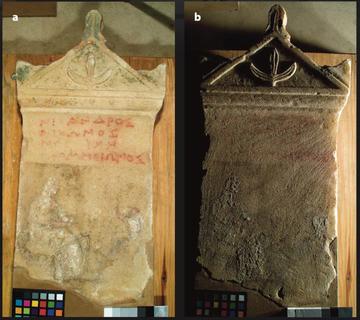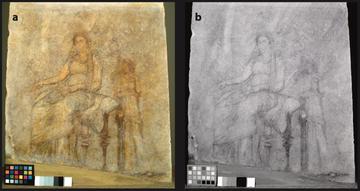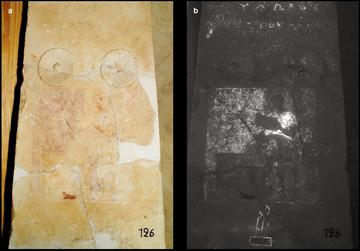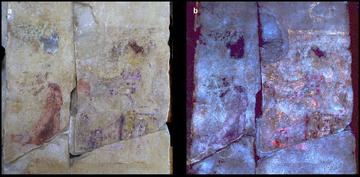
Fig. 1: Tombstone of Nikandros, son of Nikon, and No[--]iche, daughter of Promethion (Volos Λ288): a) visible light; b) RAK (© HMCS, EFA Magnesias, photos: G. Verri)
Technical imaging is a term that refers to low-tech, non-invasive and non-contact scientific techniques that may be used to visualise details otherwise invisible to the naked eye. Among others, raking light imaging (RAK) may reveal tool marks and paint texture (Fig. 1a-b).

Fig. 2: The figured scene of the tombstone of Archidike, daughter of Aristomachos, from Tylissos on Crete (Volos Λ20): a) visible; b) IRR (© HMCS, EFA Magnesias, photos: G. Verri)
Infrared-reflected imaging (IRR) can reveal the presence of preparatory drawings or enhance the visualisation of carbon-based paint, such as lamp black (Fig 2a-b).
Ultraviolet-induced luminescence imaging (UIL) helps in mapping the presence of organic materials, such as madder, a plant extract commonly used to paint pinks and reds (Fig 3a-b).
In this type of imaging, madder lake shows up as ‘glowing pink’. Visible-induced luminescence imaging (VIL) can instead visualise the presence of Egyptian blue, a man made pigment used by itself for vivid blues, or in combination with other pigments to make a variety of hues, from skin tones, to bright whites, browns, greens and purples (Fig 4a-b).

Fig. 4: The tombstone of Theudoros, son of Arisstokles (Volos Λ126): a) visible; b) VIL (© HMCS, EFA Magnesias, photos: G. Verri)

Fig. 3: The figured scene of the tombstone of Bio, daughter of Zenon (Volos Λ22): a) visible; b) UIL (© HMCS, EFA Magnesias, photos: G. Verri)